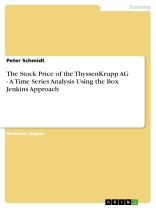Seminar paper from the year 2008 in the subject Business economics – Banking, Stock Exchanges, Insurance, Accounting, grade: 1, 0 (A), University of Wisconsin-Milwaukee (Department of Economics), course: Applied Econometrics, language: English, abstract: In this paper the Box- Jenkins forecasting technique should be applied to the stock price of the Thyssen Krupp AG. Thyssen Krupp arose from the merger of the “Thyssen AG”
and the “Friedrich Krupp AG Hoesch-Krupp” in 1999. The main focus of the trust lies on steel, industrial goods and services with its five sections Stainless, Steel, Technologies, Elevator and Services. With 191, 350 employees in over 70 countries and a turnover of 51.7 billion Euro p.a., Thyssen Krupp is one of the largest industry and technology groups in the world. At the same time it is Germany’s biggest steel and armaments manufacturer. I chose the stock price of the Thyssen Krupp trust for several reasons. First, it is a blue chip listed on the stock exchange since 1999 allowing me easy access to a sufficient and reliable
amount of data. Second, I have no reason to believe that this trust underlies any influence of seasonality since it has so many different segments that contribute to its economic
performance. Third, since the steel demand and thus prices are steadily increasing in the last years it is not surprising that the stock price of the Thyssen Krupp AG does this too (see
figure 2 further down) giving me a reason to question financial market theories. In particular, financial investors and researches are very often interested to predict future
values of stock prices. On the one hand they do so, to gain profits from investing in stocks from buying at a low price and selling at a higher price and on the other hand to verify if
financial markets work efficiently. For the latter reason, financial research for a long time believed stock prices to follow a random walk and thus that prices of the stock market
cannot be predicted2. This implies that financial markets are at least weak form efficient and excess returns cannot be earned by using investment strategies based on historical shareprices, i.e. time- series analyses can not be used to predict future values of stock prices. In this paper I will try to find out if the stock price of the Thyssen Krupp AG follows a random walk or not using the Box-Jenkins forecasting approach. For my analysis I use the weekly opening stock price starting at 01/01/2003 and ending at 04/21/08 and thus I have 278 observations. To analyze the data I use the software STATA (version 9.1.).
and the “Friedrich Krupp AG Hoesch-Krupp” in 1999. The main focus of the trust lies on steel, industrial goods and services with its five sections Stainless, Steel, Technologies, Elevator and Services. With 191, 350 employees in over 70 countries and a turnover of 51.7 billion Euro p.a., Thyssen Krupp is one of the largest industry and technology groups in the world. At the same time it is Germany’s biggest steel and armaments manufacturer. I chose the stock price of the Thyssen Krupp trust for several reasons. First, it is a blue chip listed on the stock exchange since 1999 allowing me easy access to a sufficient and reliable
amount of data. Second, I have no reason to believe that this trust underlies any influence of seasonality since it has so many different segments that contribute to its economic
performance. Third, since the steel demand and thus prices are steadily increasing in the last years it is not surprising that the stock price of the Thyssen Krupp AG does this too (see
figure 2 further down) giving me a reason to question financial market theories. In particular, financial investors and researches are very often interested to predict future
values of stock prices. On the one hand they do so, to gain profits from investing in stocks from buying at a low price and selling at a higher price and on the other hand to verify if
financial markets work efficiently. For the latter reason, financial research for a long time believed stock prices to follow a random walk and thus that prices of the stock market
cannot be predicted2. This implies that financial markets are at least weak form efficient and excess returns cannot be earned by using investment strategies based on historical shareprices, i.e. time- series analyses can not be used to predict future values of stock prices. In this paper I will try to find out if the stock price of the Thyssen Krupp AG follows a random walk or not using the Box-Jenkins forecasting approach. For my analysis I use the weekly opening stock price starting at 01/01/2003 and ending at 04/21/08 and thus I have 278 observations. To analyze the data I use the software STATA (version 9.1.).
Language English ● Format PDF ● Pages 26 ● ISBN 9783640264728 ● File size 0.6 MB ● Publisher GRIN Verlag ● City München ● Country DE ● Published 2009 ● Edition 1 ● Downloadable 24 months ● Currency EUR ● ID 4023096 ● Copy protection without












